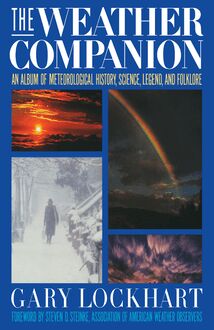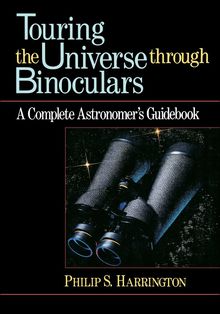Touring the Universe through Binoculars , livre ebook
184
pages
English
Ebooks
1990
Vous pourrez modifier la taille du texte de cet ouvrage
Obtenez un accès à la bibliothèque pour le consulter en ligne En savoir plus
Découvre YouScribe en t'inscrivant gratuitement
Découvre YouScribe en t'inscrivant gratuitement
184
pages
English
Ebooks
1990
Vous pourrez modifier la taille du texte de cet ouvrage
Obtenez un accès à la bibliothèque pour le consulter en ligne En savoir plus
Publié par
Date de parution
01 octobre 1990
Nombre de lectures
0
EAN13
9781620459492
Langue
English
Poids de l'ouvrage
1 Mo
Publié par
Date de parution
01 octobre 1990
Nombre de lectures
0
EAN13
9781620459492
Langue
English
Poids de l'ouvrage
1 Mo
Touring the Universe through Binoculars
The Wiley Science Editions
The Search for Extraterrestrial Intelligence , by Thomas R. McDonough
Seven Ideas That Shook the Universe , by Bryan D. Anderson and Nathan Spielberg
Space: The Next Twenty-Five Years , by Thomas R. McDonough
The Body in Time , by Kenneth Jon Rose
Clouds in a Glass of Beer , by Craig Bohren
The Complete Book of Holograms , by Joseph Kasper and Steven Feller
The Scientific Companion , by Cesare Emiliani
Starsailing , by Louis Friedman
Mirror Matter , by Robert Forward and Joel Davis
Gravity s Lens , by Nathan Cohen
The Beauty of Light , by Ben Bova
Cognizers: Neural Networks and Machines That Think , by Colin Johnson and Chappell Brown
Inventing Reality: Physics as Language , by Bruce Gregory
Planets Beyond: Discovering the Outer Solar System , by Mark Littmann
The Starry Room , by Fred Schaaf
Ozone Crisis: The 15-Year Evolution of a Sudden Global Emergency , by Sharon Roan
The Endangered Kingdom , by Roger DiSilvestro
Serendipity: Accidental Discoveries in Science , by Royston M. Roberts
Senses and Sensibilities , by Jillyn Smith
The Atomic Scientists: A Biographical History , by Henry Boorse, Lloyd Motz, and Jefferson Weaver
The Starflight Handbook: A Pioneer s Guide to Interstellar Travel , by Eugene Mallove and Gregory Matloff
Levitating Trains Kamikaze Genes: Technological Literacy for the 1990s , by Richard P. Brennan
Journey Through Genius: The Great Theorems of Mathematics , by William Dunham
Reality s Mirror: Exploring the Mathematics of Symmetry , by Bryan Bunch
Touring the Universe through Binoculars
A Complete Astronomer s Guidebook
Philip S. Harrington
Wiley Science Editions
John Wiley Sons, Inc.
New York Chichester Brisbane Toronto Singapore
To Dorothy, Wendy, and Helen: Three generations of love and encouragement
Recognizing the importance of preserving what has been written, it is a policy of John Wiley Sons, Inc. to have books of enduring value published in the United States printed on acid-free paper, and we exert our best efforts to that end.
Copyright 1990 by John Wiley Sons, Inc.
All rights reserved. Published simultaneously in Canada.
Reproduction or translation of any part of this work beyond that permitted by section 107 or 108 of the 1976 United States Copyright Act without the permission of the copyright owner is unlawful. Requests for permission or further information should be addressed to the Permissions Department, John Wiley Sons, Inc.
Library of Congress Cataloging-in-Publication Data
Harrington, Philip S.
Touring the universe through binoculars / Philip S. Harrington.
p. cm. - (Wiley Science editions)
Includes bibliographical references.
ISBN 0-471-51337-7
1. Astronomy-Observers manuals. 2. Binoculars. I. Title. II. Series. QB64.H37 1990 523-dc20 90-35740
Cover photo by Eric Hilton.
Printed in the United States of America
90 91 10 9 8 7 6 5 4
Preface
Star-gazing was never more popular than it is now. In every civilized country many excellent telescopes are owned and used, often to very good purpose, by persons who are not practical astronomers, but who wish to see for themselves the marvels of the sky. And with the aid of an opera-glass most interesting, gratifying and, in some instances, scientifically valuable observations may be made of the heavens.
So wrote Garrett P. Serviss in the opening of his classic 1888 work, Astronomy with an Opera-Glass , the first book written about observing the universe through binoculars. It is fascinating how, a century after its publication, we may repeat his message with equal validity. With the recent launch of the Hubble Space Telescope, the promise of a rekindled U.S. space program, and an increased awareness of celestial events, public interest in astronomy has never been greater. Many people now realize that there is a lot going on over their heads.
Astronomy may be the oldest science, but it is anything but static. Today, our picture of the universe is so radically different from those earlier times, that Mr. Serviss and his contemporaries could not even begin to imagine it. A century ago, astronomers spoke of canals on Mars and the possibility of a Planet X beyond Neptune and another within the orbit of Mercury. They were perplexed by the strange spiral-shaped clouds that were seen across the sky. Many were found, but their origin and significance were not understood.
These riddles have been solved over the past hundred years. The Martian canals and the mysterious innermost planet are both dismissed as misinterpreted observations. The enigma of Planet X was answered in 1930 with the discovery of Pluto. Finally, with the application of photography to astronomy, those odd pinwheel nebulae were resolved into distant galaxies. Each was found to be a complete star system in itself, much like the Milky Way galaxy.
Today, other questions have replaced those of our forebears. We yearn to find out more about pulsars, quasars, and black holes. Did the universe originate from a colossal explosion 18 billion years ago? Will it continue to expand forever, or will it stop and reverse direction?
Like children, we have just started to take our first unsteady steps off of our own world and out into the Solar System. As space probes answer our questions about our celestial neighborhood, they raise others we never even thought to ask. Some will have to wait for future missions to answer them; the remainder will have to wait for future generations. There is still so much to learn.
Large telescopes and space probes are not needed to discover the heavens. Even the simplest binoculars will begin to reveal sights that were unsuspected or unrecognized in the days of Garrett Serviss.
Touring the Universe through Binoculars is intended to be the most thorough examination of the binocular sky ever compiled. Throughout its pages, you will find a wealth of objects and projects for amateurs who, like me, have made a conscious choice to use binoculars. To tell you the truth, I really wrote this book for myself! There is an abundance (dare I say, overabundance) of books on the market today that sing the praises of large-aperture, sophisticated instruments. Most of these books are quite good, but their intent is not for binocular observers.
Beginning with the Moon, we tour the Solar System and then escape the realm of our Sun to visit the stars. Over 1,100 deep sky objects visible through binoculars are listed. Of these, the appearance of more than 400 have been described in detail. Now, I am not saying that all are seen better through binoculars than through a telescope; that simply is not the case. Still, many are best viewed using low power and a wide field of view, and some cannot even be seen at all through the restrictive eyes of telescopes.
I welcome your comments, especially if you should find any errors (Gadzooks)! Just write to me in care of the publisher, John Wiley Sons, Inc. I shall endeavor to answer all letters, but in case I miss yours, thank you in advance!
Gaze skyward on the next clear evening. The universe awaits.
Acknowledgments
While the book that you hold before you is the product of one pen, I wish to take a moment to thank the many individuals who have contributed to its ultimate success. Throughout the book, you will find what I judge to be some magnificent astrophotographs. These marvelous pictures were taken by Jim Barclay, Lee Coombs, Dennis diCicco, James Fakatselis, Martin Germano, Johnny Home, Jeffrey Jones, Brian Kennedy, Jack Newton, George Viscome, Bernard Volz, and Kim Zussman. Take it from me, they are among the best amateur astrophotographers around today, and I thank them for their input.
I also wish to thank Jerry Burns, John Riggs, Pearson Menoher, Norman Butler, and Lee Cain. They constructed the unique binoculars and binocular mounting systems which you will find detailed in Appendix B .
I wish to extend my sincere appreciation to my proofreaders Richard Sanderson, Jack Megas, and Edward Pascuzzi, who read the manuscript over and over again and so eloquently passed on suggestions while dealing with my fragile ego. Aiding me in many different ways behind the scenes were Eric Hilton, John Kamon, David Eicher, Frederick Bump, and Louis Renzulli. Many thanks also to David Sobel and Frank Grazioli of John Wiley Sons, and to Laura Cleveland of WordCrafters, for their patient guidance and help to this virgin book author.
Finally, to my wife Wendy, who proofed the final manuscript and provided endless encouragement over the years it took to compile the book: I simply could not have done it without you!
Contents
1 Why Binoculars?
2 The Moon
3 The Planets
4 Minor Members of the Solar System
5 The Sun
6 Stellar Happenings
7 A Survey of the Night Sky
Appendices
A Caveat Emptor! (Let the Buyer Beware!)
B Mounting Concerns
C Care, Maintenance, and Other Tidbits
D Binocular Manufacturers
E Converting Universal Time to Local Time
F For Further Information
G Bibliography
Index
1
Why Binoculars?
Why bother with binoculars? Today s amateur astronomers have a vast array of telescopic equipment and accessories from which to choose. Huge telescopes, advanced optical designs, and special accessories that were once considered to be only in the realm of the professional are now readily available to the hobbyist. With all this, why would anyone want to use plain old binoculars?
The answer is that, for all the diversity of instrumentation, one of the most useful, yet often neglected instruments to tour the universe with is a pair of binoculars. Their low power and wide field of view make binoculars ideal for either a casual scan or some pretty sophisticated observing.
Research has shown that when it comes to viewing the heavens, two eyes are definitely better than one. Our power of resolution and ability to detect fai


